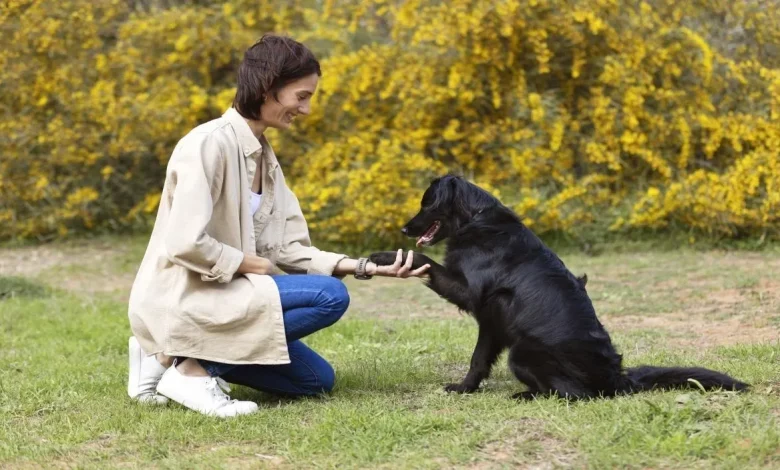From Ruff to Refined: Transforming Your Dog’s Behavior through Training

Key Takeaways
- Training enhances the dog-owner bond and enriches the pet’s life.
- Identify and customize training to address specific behavioral needs.
- Use positive reinforcement methods for effective learning.
- Practice basic commands regularly and consistently.
- Address behavioral issues by understanding underlying causes.
- Socialization is vital for a well-adjusted and confident dog.
- Consistency in commands and patience is crucial for practical training.
- Reward and celebrate progress to maintain a positive training experience.
Introduction
Training a dog involves more than simply instructing them on commands; it is a path to better the dog’s conduct and strengthen the bond between the pet and the owner. This enlightening journey not only elevates a dog’s existence by fostering their social skills and adaptability but also contributes to a peaceful atmosphere in the home. An experienced pet owner once said, “It isn’t just training your dog; it’s building a friendship that lasts.” Let’s explore the benefits and steps of training your dog from rough to refined.
The Benefits of Dog Training
Training your dog can significantly improve your and your pet’s quality of life. One of the most notable benefits is the deepened bond that develops through consistent, positive interaction. Training sessions provide mental stimulation, reducing anxiety and problematic behaviors. Moreover, trained dogs are typically healthier, more active, and less likely to exhibit stress-related behaviors such as chewing or excessive barking. For instance, experienced trainers like Rob’s Dogs emphasize that training helps dogs learn their boundaries, making their behavior more predictable and manageable.
Getting Started: Assessing Your Dog’s Needs
The journey of training begins with understanding your dog’s specific needs. Are particular behaviors requiring correction, such as jumping on guests or pulling on the leash during walks? Each dog has challenges based on breed, age, and past experiences. In cities known for their active lifestyle, like those facilitating dog training in Phoenix, trainers often advise conducting a behavioral assessment to tailor the training approach effectively. This personalization ensures that common and unique behavioral issues are addressed with the proper strategies.
Choosing the Right Training Methods
The effectiveness of dog training is heavily influenced by the methods chosen. Positive reinforcement has become increasingly favored because of its kind and efficient characteristics. Rather than punishing undesired behavior, it rewards desired actions with treats, praise, or playtime. Such methods strengthen the bond between you and your dog and instill a willingness to learn. Clicker training, for example, provides immediate feedback and is celebrated for its efficacy in teaching new commands.
Basic Commands Every Dog Should Know
Basic commands such as “sit,” “stay,” “come,” and “down” are foundational elements of a well-behaved dog. These commands facilitate better control and communication, ensuring safety in various situations. Consistent practice is crucial—regular, short training sessions are more beneficial than occasional lengthy ones. By reinforcing these commands daily, dogs learn to respond promptly and accurately, making interactions smoother and more enjoyable.
Addressing Behavioral Issues
Behavioral problems like aggression, fear, or excessive barking can strain the human-dog relationship. It’s essential to address these issues with patience and understanding, identifying the root causes rather than merely treating the symptoms. Professional advice can be invaluable here, offering insights into practical strategies for modification. Creating a calm environment and gradually introducing new experiences can mitigate many problematic behaviors, paving the way for a happier, more confident dog.
The Role of Socialization in Behavior Training
Socialization is a critical component of successful dog training. Exposing dogs to various environments, people, and other animals helps them adapt to new situations without fear or aggression. Positive social interactions encourage dogs to be friendly and well-adjusted, reducing the likelihood of anxiety-related behaviors. Regular exposure to diverse settings builds confidence and enriches their experiences, contributing to their well-being.
Maintaining Consistency in Training
Consistency is fundamental in dog training. Success relies on everyone involved in the dog’s life using the same commands and reinforcements. Inconsistencies can confuse dogs, slowing down the learning process. Commitment to daily practice helps reinforce learning and keeps your dog engaged. Patience is equally important; not every dog learns at the same pace, and understanding this can prevent frustration for both dog and owner.
Celebrating Successes and Progress
Celebrating your dog’s successes, no matter how small, is crucial in maintaining motivation and joy in training—rewards, whether as treats, toys, or extra playtime, should be meaningful to the dog. Acknowledging progress reinforces desired behavior and showcases the dog’s and the owner’s achievements. This positive reinforcement encourages continued learning and strengthens the bond further.
Conclusion
In summary, transforming your dog’s behavior through training is rewarding and benefits both the dog and the owner. From understanding individual needs to choosing appropriate training methods and maintaining consistency, every step is crucial in shaping a well-behaved, content pet. Moreover, this journey nurtures a deeper bond that enhances your companionship. Keep in mind that perseverance and patience are essential. Acknowledge every achievement and take pleasure in improving your pet’s conduct.





